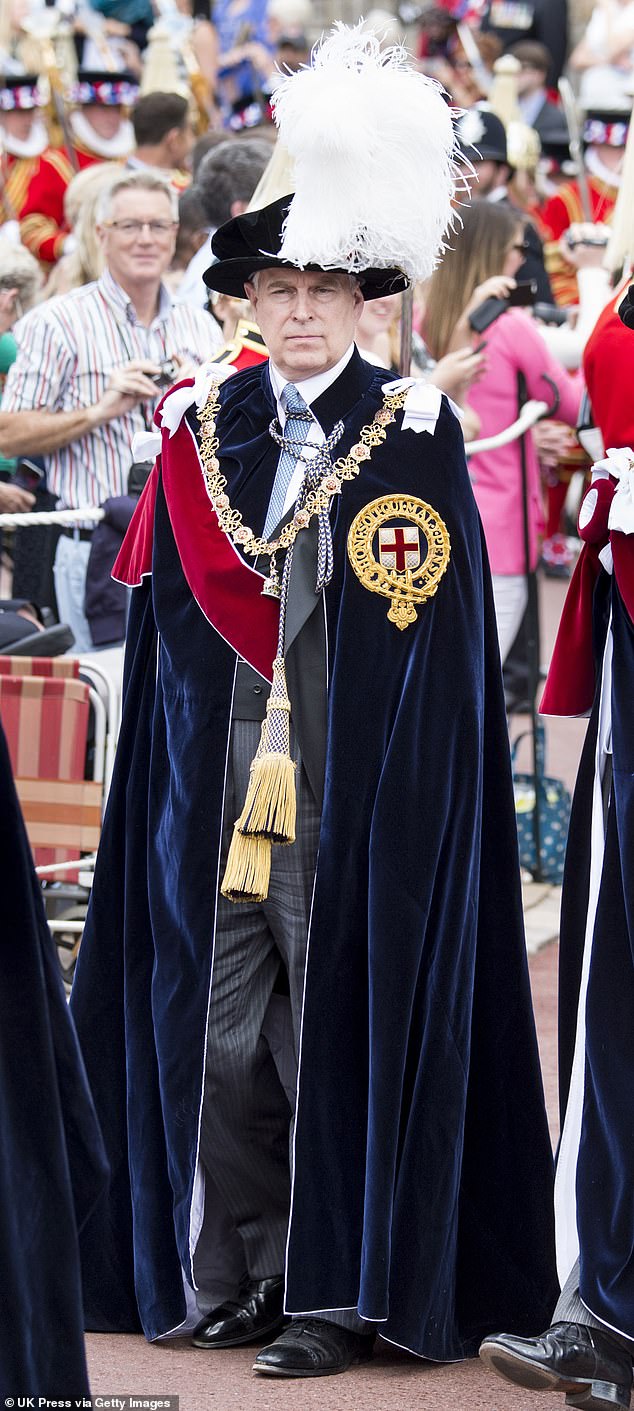When nobleman Osbert Giffard abducted two nuns from a nunnery in 1286, he was deemed to no longer represent the very finest chivalry that England expected, and it was ordered he ‘be deprived’ of his ‘spurs, saddle, bridle and sword’.
It was this aristocratic miscreant’s banishment from English high society that helped inspire the fabled Order of the Garter, which was proclaimed in 1348 to uphold the greatest honour and impose severe reprimands for any knights guilty of ‘bringing shame’.
The Most Noble Order of the Garter was founded by King Edward III, and is Britain’s most senior order of chivalry.
Prince Andrew was made one of its royal knights in 2006. Since the 14th Century, membership has been bestowed by the sovereign personally for exceptional service to Crown or contribution to national life.
Now Andrew has relinquished his highest honour, alongside the use of his dukedom, it will be for history to judge how he fares in comparison to the rogues gallery of his disgraced predecessors thrown out of the Order of the Garter.
A century or so after Giffard’s run-in with the nuns, Garter member Sir Ralph Grey fell foul of its rules during a War of the Roses battle in which he, a Lancastrian, was defeated by forces from Yorkshire and duly denounced as a traitor to the King, Edward IV of the House of York.
In 1464, Sir Ralph was sentenced to ‘have his spurs struck from his heels by the cook’, and for his coat of arms to be ‘torn from his body’, historian Stephanie Trigg records. If that wasn’t bad enough, he was ordered to wear a ‘reversed’ coat of arms.
If Sir Ralph had optimistically hoped such humiliations – dreadful though they were in 15th century high society – might settle his punishment, he would have been disappointed to discover they were merely to be carried out on his way to visit an executioner who then duly cut off his head.
Prince Andrew at the Order of the Garter in June 2015 outside St George’s Chapel in WIndsor

The former Emperor of Japan Hirohito in 1935. Hirohito was removed from the order during World War Two where Japan fought alongside Nazi Germany against the UK and the Allies

Sir Ralph Grey (pictured) was stripped of his title before having his head chopped off
Indeed over the long and bloodied history spanned by the Order of the Garter, those who besmirch its distinguished reputation have felt the sharp end of an executioner’s blade before any appeals to European-style judges were invented.
These days, the sanctions may be less physically acute, but they remain reputationally fatal. In nearly 700 years, only around 40 knights of the Garter have been subjected to the process of ‘degradation’, the name for being kicked out.
While Andrew has not suffered that fate, with his title in abeyance, he is still among dubious company, alongside the likes of Emperor Hirohito of Japan, who was ‘degraded’ in 1941.
In Hirohito’s case, it was felt the honour of chivalry was incompatible with the fact that his bloodthirsty troops were waging a brutal campaign of terror on British soldiers forced to work – and die – on the Burma Railway.
And yet even Emperor Hirohito, after the Second World War, had his membership restored by the late Queen, in 1971, to symbolise renewed diplomatic relations.
Her late husband Prince Philip was once quoted as saying of the Garter: ‘It’s a nice piece of pageantry which I think a lot of people enjoy…rationally, it’s lunatic, but in practice everyone enjoys it, I think.’
It was, perhaps inevitably, Henry VIII who gave proper consideration to the punishments to be bestowed on miscreant knights. Between 1516 and 1519, he revised the statutes to include the specific measure of ‘degradation’ for ‘any knights who be living in a disgraceful manner’.
In the fourteenth century, Robert de Vere, Earl of Oxford, was ‘degraded’ after being found guilty of treason. He fled and was sentenced to death in absentia, but ended up dying in 1392 of injuries sustained in a boar hunt.
In 1397, Thomas Beauchamp, Earl of Warwick, was dumped from the Order of the Garter after being charged with high treason and thrown in the Tower of London, although he was later let off.
dailymail,royals,Royals,England
#Prince #Andrew #joins #rogues #gallery #disgraced #noble #men #removed #Order #Garter #including #nunabducting #knight #Emperor #Hirohito

